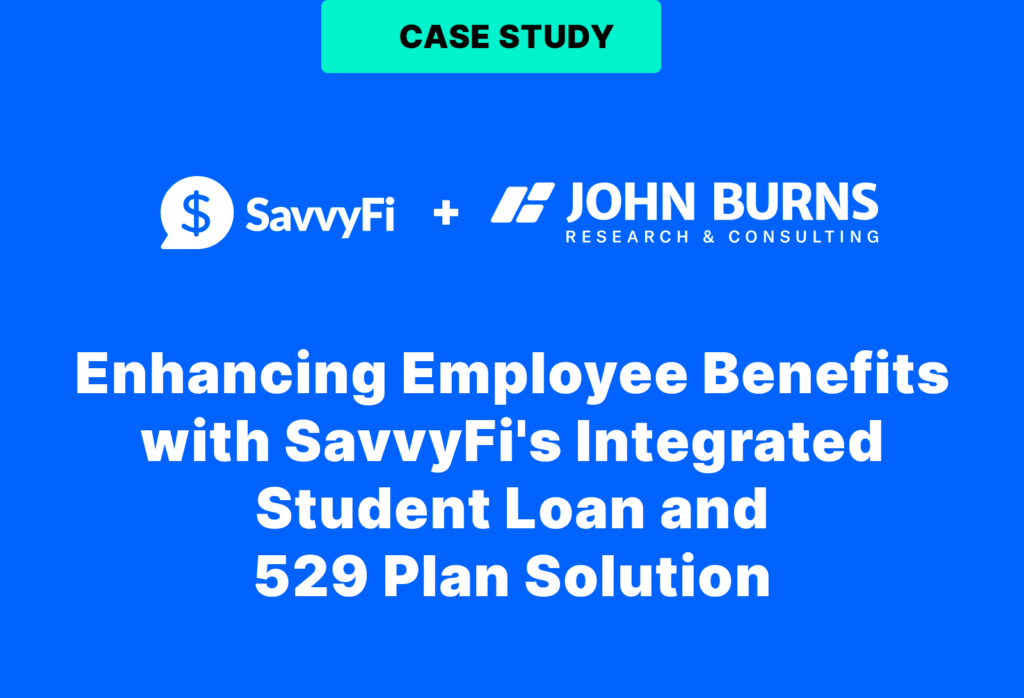With student debt reaching new heights and the future of student loans uncertain, employees are feeling the pressure more than ever. As an employer, it’s tough to watch your team struggle with financial stress while you’re trying to stay competitive in an ever-changing job market.
But offering educational finance benefits like 529 plans, student loan repayment assistance, and tuition reimbursement isn’t just a great way to support your team—it’s also a smart financial move. These benefits provide tax advantages for both employees and employers, helping employees reduce their tax burdens while allowing employers to take advantage of deductions and credits.
At the same time, lifestyle benefits like pet insurance, caregiving support, and wellness stipends help employees balance their personal and professional lives. These perks may not have the same direct tax advantages, but they offer immense value in terms of employee well-being and retention.
So how can you offer benefits that are genuinely helpful in today’s world? In this guide, we’ll walk you through how these perks compare, which ones serve your employees best, and how you can create a win-win situation for both your team and your business.
First, let’s define the core education finance benefits.
Here’s a clear breakdown of five common education-related benefits:
- 529 Plans
- Student Loan Repayment Assistance
- Student Loan Retirement Match
- Tuition Reimbursement
- Public Service Loan Forgiveness (PSLF).
1. What is a 529 College Savings Plan?
- Pays for: Future education expenses (K-12, college, trade school, student loan repayment up to $10,000)
- Tax Advantages (Employee): Tax-free investment growth and withdrawals for qualified education expenses
- Tax Advantages (Employer): Potential state tax deductions (varies by state); contributions are not federally tax-deductible but may be in some states
- 5-Year Scenarios:
- Employee contributes $0: $0 saved
- $50/month: ~$3,400 saved (assuming 5% return)
- $100/month: ~$6,800 saved (assuming 5% return)
- Employer contributes $0 / $50 / $100: Add corresponding amount to above totals; potential total ~$13,600 with $100 employee + $100 employer
2. What is Student Loan Repayment Assistance?
- Pays for: Past education debt
- Tax Advantages (Employee): Up to $5,250/year tax-free through 2025 under CARES Act (may be extended)
- Tax Advantages (Employer): Contributions up to $5,250/year are tax-deductible
- 5-Year Scenarios:
- Employee contributes $0: Loan remains, interest accrues
- $50/month: ~$3,000 paid toward principal
- $100/month: ~$6,000 paid toward principal
- Employer contributes $0 / $50 / $100: Equivalent reductions in principal, faster debt payoff, and reduced interest costs
3. What is Student Loan Retirement Match ?
- Pays for: Past education debt, indirectly funds future retirement (put into effect with SECURE Act 2.0)
- Tax Advantages (Employee): Loan payment qualifies as “deferral” for retirement match; match goes into 401(k)/403(b)
- Tax Advantages (Employer): Normal retirement match rules apply (tax-deductible contributions)
- 5-Year Scenarios:
- Employee contributes $0 to loans: No match
- $50/month: ~$3,000 in payments; employer could match ~$3,000 into retirement
- $100/month: ~$6,000 in payments; same potential match into retirement
4. What is Tuition Reimbursement?
- Pays for: Present education costs
- Tax Advantages (Employee): Up to $5,250/year tax-free (IRS Section 127)
- Tax Advantages (Employer): Tax-deductible up to $5,250/year
- 5-Year Scenarios:
- Employee contributes $0: No additional education
- $50/month: May help cover books, partial tuition
- $100/month: Covers a portion of tuition per semester
- Employer contributes $0 / $50 / $100: Scaled support for current degree/certificate program
5. What is Public Service Loan Forgiveness (PSLF)?
- Pays for: Past debt (federal loans only)
- Tax Advantages (Employee): Forgiven balance is tax-free
- Tax Advantages (Employer): None directly; potential recruitment/retention benefits
- 5-Year Scenarios:
- Employee contributes $0: Must make 120 qualifying monthly payments (10 years)
- $50/month: Only counts if it’s a qualifying IDR plan; benefit realized after full 10 years
- $100/month: Speeds up progress; no impact on forgiveness amount but helps ensure qualification
- Employer contributes: Indirect support via education or tools to stay eligible
Education Finance Benefits Summary Table

View as a PDF: Education Finance Benefits Summary Table
Employers have more options than ever to support education-related financial wellbeing. Whether the goal is to attract top talent, reduce turnover, or support long-term planning, these programs can be powerful tools when used strategically—especially when combined.
Next, how do education finance benefits perform compared to other fringe benefits?
Below we’ve broken down a comparison of education benefits (like 529s, student loan repayment, tuition reimbursement) with other fringe benefits (like caregiving support, pet insurance, wellness stipends, etc.).
View this as a PDF: Compare Education Finance and Fringe Benefits
Key Takeaways Comparing Fringe Benefits:
- Most tax-efficient benefits: Student loan repayment, tuition reimbursement, and 529s (when structured right).
- Most emotionally resonant: Education, caregiving, and loan forgiveness benefits have a high “felt impact” among employees.
- Pet and wellness perks may feel good but tend to be more lifestyle-oriented than financially strategic.
- Education-based benefits not only provide tax advantages but also signal long-term investment in employees.
Where Educational Benefits Stand Out
Educational finance benefits don’t just check a box. They create momentum.
They are emotionally sticky. Education is tied to personal goals and family legacies.
They are financially strategic. Many offer tax advantages for both employee and employer.
They are inherently long-term. They compound over time, reinforcing loyalty.
Framing the ROI: 4 Business Challenges
1. High Turnover (Especially in Early-Career Roles)
- Early-career hires often leave within 12–24 months
- Cost of turnover is high due to lost productivity and rehiring
- Educational benefits create strong long-term incentives to stay
Younger employees often feel financial pressure from student loans and lack of clear career growth. Many exit within their first 1–2 years. Educational benefits such as student loan repayment or 529 contributions offer meaningful reasons to stay by helping employees reduce debt or invest in their future. Structuring benefits with tenure-based milestones (e.g., increases at year 1, 3, 5) can further improve retention.
2. Non-Competitive Compensation
- Salary gaps can limit your ability to attract top talent
- Education benefits provide high-value support at lower cost
- Ideal for mission-driven orgs or public/nonprofit sectors
When your salary ranges can’t compete with the private sector, it’s critical to differentiate with non-cash value. Offering $100/month toward student debt or 529 savings can deliver outsized value to employees, especially younger workers with debt. These benefits help you remain competitive in a talent market without needing to stretch salary bands.
3. Low Utilization of Traditional Benefits
- Many HR benefits see poor engagement or go unused
- Education-related benefits are tied to personal financial goals
- Easier to communicate, track, and value
Gym stipends and wellness programs often get lost in the shuffle. In contrast, education benefits are emotionally and financially relevant. Whether helping employees reduce debt or save for their children, these benefits are more likely to be used—and appreciated. They also offer clear ROI through participation and financial outcomes.
4. Retention of Licensed / Credentialed Staff
- Roles in healthcare, education, and behavioral health often require ongoing certification
- Continuing education is costly and time-consuming
- Tuition reimbursement and debt support reduce burnout and churn
Licensed professionals often face pressure to stay current with certifications or coursework. Without support, this burden can lead to turnover or dissatisfaction. Providing reimbursement or student loan assistance signals that the organization is invested in their professional growth and willing to share the load—leading to longer tenure and higher morale.
Ready to Rethink Retention?
Whether you’re grappling with high turnover, compensation constraints, or a low utilization of fringe and other benefits, the right education benefits can move the needle—in ways traditional perks just can’t.
At SavvyFi, we’re helping forward-thinking employers implement creative, tax-advantaged strategies that deliver real value to employees and the business. If you’re ready to take the next step, join us for our upcoming webinar:
Beyond Salary: 7 Creative Ways to Keep Your Best Employees | Live Webinar | May 15 at 11 AM CST
In just 30 minutes, we’ll share practical, low-cost benefit strategies our clients are using right now to boost morale, stand out in the hiring market, and reduce costly turnover.
Reserve your spot now and get inspired by what’s working. (Register here.)
Have questions before then? Chat with us anytime. We’re here to help you build a benefits strategy that works beyond salary.
About SavvyFi: SavvyFi is a user-friendly fintech platform that makes it easy for employers to provide college savings and student loan benefits to their employees. Because the company’s platform is “zero-touch” to HR — without any complicated systems, integrations, or paperwork — SavvyFi unlocks education financing capabilities to even the smallest employers that would not otherwise be able to offer these benefits.
Disclosure: Third-party quotes shown may not be representative of the experience of all SavvyFi customers and do not represent a guarantee of future performance or success.






